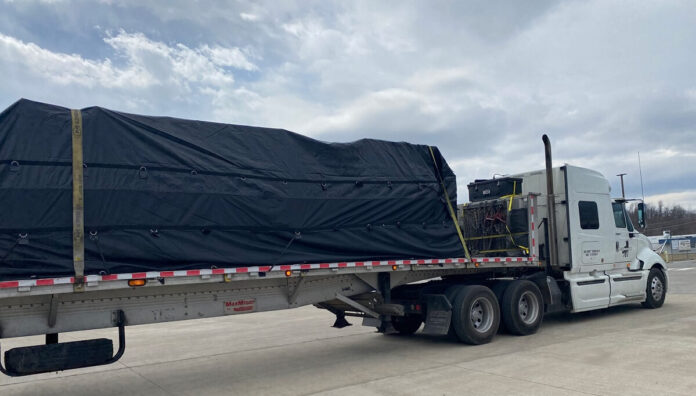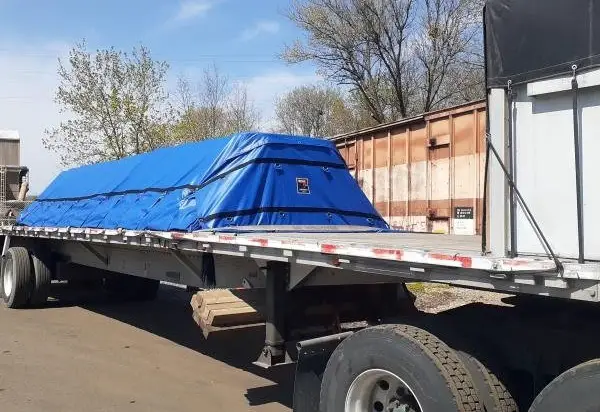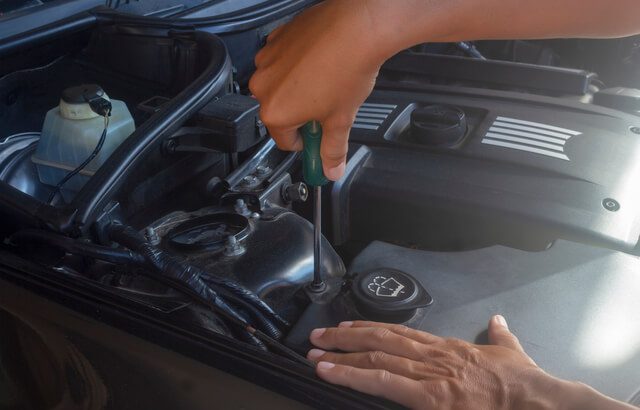
Flatbed truckers need to protect their loadload by any means necessary. Flatbed trailer tarps are one of the best ways to do so. These heavy-duty sheets help protect your cargo from Mother Nature’s harmful elements, such as wind, rain, and dust. Though, it’s important that you tarp your materials the right way. An improper tarping system could spell trouble. You want your materials delivered safe and sound. After reading this blog, you’ll become a pro at flatbed tarping.
Reasons for Tarping a Flatbed Load

Tarping your flatbed loadload may seem like a nuisance, but securing your materials is important. A Flatbed Tarp adds extra protection to your loadload against road hazards and climate changes. Tarping is more often than not done during the winter time to protect the cargo from salt off the roads.
Not only are you protecting the product you’re hauling, but also other drivers on the road. If your materials aren’t properly contained, they could hit another driver’s windshield. Ultimately, you could lose your job and even have a bad reputation.
How to Tarp Your Flatbed Loads
In addition to understanding why you should tarp a flatbed load, you must also know how it’s done. Following these steps will keep you and your materials safe throughout the ride. This guideline will help you avoid fatal accidents and mistakes that cost you hundreds. Let’s take a look:
1. Secure the loadload:
First and foremost, you want to secure your loadload. It’s better to start securing your materials before you put up a tarp; otherwise, you’ll lose sight of your attachment points. In any case, make sure you’ve secured your loadload first. It’s the most crucial step to ensure you’re protecting your materials.
2. Select Your Right Tarps:
It’s also important to know what kind of materials you’re hauling before you start tarping. Once you know this information, you can select the tarp that best suits your needs. Though, don’t just stop at one tarp. It’s common to have multiple tarps to cover your loads, especially if oversized.
3. Start Unrolling & Rolling the Flatbed Tarps:
Next, you’ll need to know how to roll and unroll your Flatbed Tarps effectively. A rule of thumb for doing either procedure is to start at the back of your loadload and work your way to the front. Moreover, use a multi-position ladder to climb on top of your freight and perform this step. If you’re using multiple tarps, lay them down at the back of the loadload and put one on top. The end flap of the tarp should be facing the back of the loadload. This allows the wind to pass right over it and prevents damage to your materials.
However, if you position the flap end of the tarp to face the front of the loadload, the wind will go right underneath and create a balloon. All flaps must be folded back to prevent the wind and water from damaging your materials.
4. Secure the Tarps:
Not only must you secure your loadload, but your flatbed tarps as well. After placing your tarps on top of your loadload, secure the tarps using bungee cords. Furthermore, connect the bungee cords to the trailer through the D-rings. This equipment comes in various sizes and configurations, designed to accommodate all loads.
On the other hand, a driver may opt to use other means of securement, such as a rope and stitch, to connect the seams of a tarp. Though, others may choose to use heavy-duty tarp clips, which prevent the chance of your tarps from turning into a balloon. The goal is to ensure your tarps fit as tight as possible over your loadload.
Different Types of Flatbed Tarps

Knowing how to tarp your materials properly can go a long way in ensuring the safety of your materials. It also helps to know which tarps work best for certain loads. Refer to the list of tarps below:
Lumber Tarps:
You can guess what material works best with a Lumber Tarp. These lightweight, heavy-duty tarps were designed exclusively to protect a load full of lumber from dirt, debris, and other road hazards. Though make no mistake, these tarps can also provide security over bulky loads such as timber and hay. How exactly do you tarp a lumber load? They come equipped with a flap at the end that covers the entire flatbed loadload. Furthermore, their PVC-coated sides and tail flap offer D-rings used as securement points for your flatbed trailer.
Parachute Tarps:
Parachute or Airbag Tarps protect your loadload from weather damage. Specifically, the top is waterproof vinyl, and the sides are waterproof parachute fabric. They also feature three rows of D-rings, giving you flexible and easy cargo securement.
Steel Tarps:
Considered one of the most common tarps used in the industry, Steel Tarps can ensure your cargo’s safety. While similar to Lumber Tarps, Steel Tarps have made a name for themselves. They don’t have an end flap but make up for it with grommets and D rings. You’ll have plenty of ways to secure your cargo.
Machinery Tarps:
If you have oddly shaped and extreme cargo, you might want to use Machinery Tarps. These tarps are designed to cover items such as production and machine equipment. They also help protect your cargo from extreme vibrations and unfavorable weather conditions.
Coil Tarps:
Coil Tarp is another tarp used to cover flatbed loads. As the name suggests, these tarps are often used in the steel and aluminum industries to cover metal coils. They’re also used to protect cable coils. They also come equipped with flaps at the base and slits that allow a transport chain to pass through.
Roll Tarps:
These tarps are often used on dump trucks to help transport and contain loose material, such as hay or sand. Additionally, they help protect your cargo from the elements, UV sun rays, and debris. Roll Tarps can also help with loading and unloading procedures.
How to Protect Your Flatbed Tarps
You might want an added level of protection to ensure your tarps are secure. Several pieces of equipment could protect your Flatbed Tarps. Let’s take a look at the list of products below:
Bungee straps:
If you have worked in the trucking industry long enough, you’ll probably notice that many truckers use bungee straps to secure their loadload and tarps. Furthermore, the straps come in two styles, Natural Rubber and EPDM. The first won’t crack under below-freezing temperatures, while the second style works better in warmer conditions.
Rubber Ropes:
Alternatively, you can opt for Rubber Ropes. This equipment can be cut to any length to accommodate your cargo and Flatbed Tarps better. Moreover, there are two types of ropes: Solid and Hollow Core. The first type can be used for lightweight materials, while the second is best suited for heavy cargo.
Shock Cords:
Another heavy-duty rope that helps protect your tarps is Shock Cords. Similar to the Rubber Ropes, they can be cut to any length for your cargo and tarps. Moreover, the stretchy rope has a heavy-duty polyester fabric that encases a rubber core. A Shock Cord is arguably one of the best ways to secure my materials and protect your tarps.
Corner Protector:
Corner Protectors help protect your tarp from the sharp edges of your cargo. It’s also against the law to not have any Corner Protectors to protect your flatbed equipment, including tarps. For instance, if friction occurs between the cargo and a tarp, you could risk damaging them. The laws state that a Corner Protector must be used to prevent wear and tear.
Flatbed Tarping Is the Right Way to Go
In conclusion, tarping your flatbed loadload means you’re a trucker who values safety. There are various types of tarps you can use to ensure your materials remain safe during transit. You can also use a wealth of safety equipment to protect and secure your tarps. You can succeed at a job when you know how to tarp and protect your cargo.

I am an Automotive specialist. I graduated from Michigan with Bachelor in Automotive Engineering and Management. Also, I hold degrees in Electrical and Automation Engineering (BEng), Automatic and Industrial Electronic Engineering, and Automotive Technology. I have worked at General Motors Company for over five years as the Marketing Operations Production Coordinator. Now, I own my garage in Miami, Florida. I love cars and love to share everything about them with my readers. I am the founder of the Automotiveex blog, where I share everything about automotive, like car news, car mechanical issues, and anything else that comes up in my blog posts.









